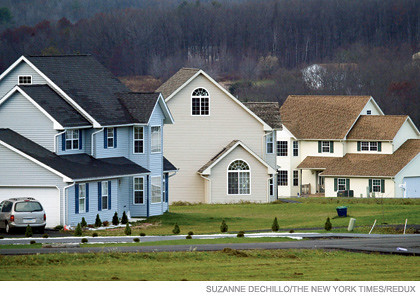The next slums? Foreclosures, demographics, crime trends don't portend well for sprawl

Posted February 19, 2008 at 5:00PM

A provocative new article in The Atlantic suggests that times are not good in the new 'burbs:
At Windy Ridge, a recently built starter-home development seven miles northwest of Charlotte, North Carolina, 81 of the community’s 132 small, vinyl-sided houses were in foreclosure as of late last year. Vandals have kicked in doors and stripped the copper wire from vacant houses; drug users and homeless people have furtively moved in. In December, after a stray bullet blasted through her son’s bedroom and into her own, Laurie Talbot, who’d moved to Windy Ridge from New York in 2005, told The Charlotte Observer, “I thought I’d bought a home in Pleasantville. I never imagined in my wildest dreams that stuff like this would happen” . . .
In the first half of last year, residential burglaries rose by 35 percent and robberies by 58 percent in suburban Lee County, Florida, where one in four houses stands empty . . .
The decline of places like [these] is usually attributed to the subprime-mortgage crisis, with its wave of foreclosures. And the crisis has indeed catalyzed or intensified social problems in many communities. But the story of vacant suburban homes and declining suburban neighborhoods did not begin with the crisis, and will not end with it. A structural change is under way in the housing market—a major shift in the way many Americans want to live and work. It has shaped the current downturn, steering some of the worst problems away from the cities and toward the suburban fringes. And its effects will be felt more strongly, and more broadly, as the years pass. Its ultimate impact on the suburbs, and the cities, will be profound.
Arthur C. Nelson, director of the Metropolitan Institute at Virginia Tech, has looked carefully at trends in American demographics, construction, house prices, and consumer preferences. In 2006, using recent consumer research, housing supply data, and population growth rates, he modeled future demand for various types of housing. The results were bracing: Nelson forecasts a likely surplus of 22 million large-lot homes (houses built on a sixth of an acre or more) by 2025—that’s roughly 40 percent of the large-lot homes in existence today . . .
The author of the article in The Atlantic, Christopher B. Leinberger, is far from a radical or a doomsayer. He is a founding partner of Aracdia Land Company, developers who have built projects in Missouri, Pennsylvania, and New Mexico. For 20 years, he was co-owner and managing director of Robert Charles Lesser & Co., the country's largest independent real estate advisory firm. Chris is currently a visiting scholar at the Brookings Institution in Washington.
Similarly, Arthur C. Nelson is a well-known and highly respected analyst and real estate researcher. These guys have tons of experience and do their homework.
Read the full article, titled The Next Slum, here.
Many thanks to NRDC alum Melissa Bez for pointing me to this article.